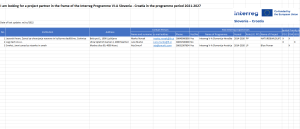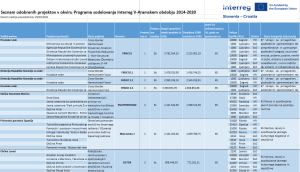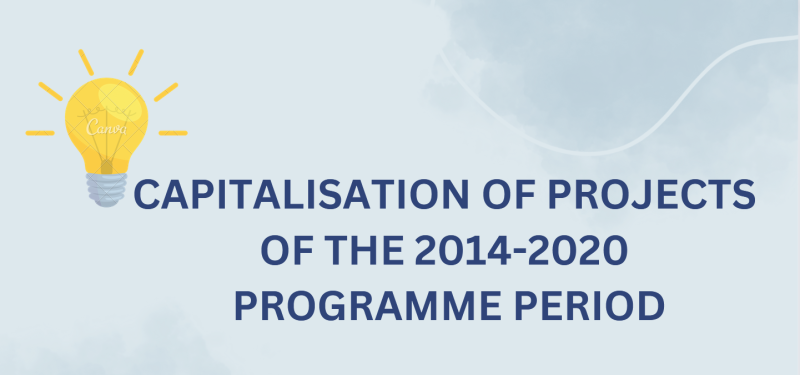Looking for a Project Partner?
Welcome to our applicant matchmaking community!
This community will help you to get in touch with other organisations from Slovenia and Croatia and facilitate bilateral exchanges in view of the upcoming call for project proposals of the Interreg Programme Slovenia – Croatia that opened on 24 March 2023 in all Priority with an indicative budget of 36,2m EUR.
If you are interested in joining a project idea or in finding partners for your own project idea, this community is the best place to start your cooperation!
List of Potential Project Partners will be updated daily.
List of Potential Project Partners
Approved Projects
10
Approved Projects
This part of the website provides information on all approved projects within the Interreg Programme Slovenia – Croatia.
PRIORITY 1

Summaries of Projects in 1st deadline – SO 2.4

Project title: Strengthening the ability of cross-border response to natural disasters
Project budget (ERDF co-financing): EUR 832.640,00
Project duration: 1. 3. 2024 – 31. 8. 2026
Project Partners: Regionalna razvojna agencija za Podravje – Maribor, Rdeči križ Slovenije – Območno združenje Maribor, Javni zavod gasilska brigada Maribor, Javna ustanova za razvoj Međimurske županije REDEA, Hrvatski Crveni križ – Gradsko društvo Crvenog križa Čakovec, Područna Vatrogasna Zajednica Otoka Krka
The cross-border area along the border between Slovenia and Croatia faces various challenges in the field of risk management and disaster recovery, where a common approach is needed. These challenges include in particular floods along the river corridors of the Mura, Drava and Sava rivers, and more recently earthquakes, fires and the humanitarian crisis linked to illegal migration flows and refugees. In the face of existing and potential new challenges, preparedness for natural and other disasters and emergencies is crucial to ensure the safety in the cross-border area.
The solidarity of both professional teams and the civilian population is at a high level, as seen in the response to major crises such as the earthquake in Petrinja, the fire in the Karst region, or the attack on Ukraine, where the willingness to help and to contribute by collecting humanitarian aid was very high, but there was an organizational problem of logistics and distribution of materials, as well as management of the human resources that were involved in dealing with and recovering from the consequences of elementary disasters and emergencies.
The ODZIV project will lay the foundations for a joint response by key stakeholders (such as: firefighters, civil protection, Red Cross) from both sides of the border, thus strengthening the capacity to respond to natural disasters in the cross-border area of Slovenia and Croatia. The project will analyze the security situation, update response protocols, create new cross-border cooperation and establish joint training for cross-border disaster risk management and disaster recovery.
An overview of the response preparedness situation will be carried out for the cross-border regions involved in the project (Podravska region, Međimurje County, Primorsko-Goranska County):
– identification of risks and needs in the cross-border area
– recording the organizations and their available equipment and logistic capacities for responding to elementary and other disasters and emergencies,
– Cross-border comparison of response protocols to natural and other disasters and emergencies.
Based on the overview, an updated protocol will be developed to allow a joint cross-border response of those organizations responsible for the response, depending on the type of risk (e.g. fire brigades). This will strengthen the capacity for joint action, allowing the pooling of resources (both material and human) to combat or deal with the consequences of elementary disasters.
As most cross-border areas are geographically rugged rural areas where the nearest response units are not always on the same side of the border as the disaster, and as disasters such as fire, flood or earthquake are not limited in cause or consequence to the area bounded by national borders, a cross-border approach is essential to enhance response capacity.
In order to ensure the quality implementation of the project, which will achieve the set objectives, a cross-border partnership has been established, which includes the Regional Development Agency for Podravje – Maribor (lead partner), the Slovenian Red Cross – Maribor Regional Association, the Maribor Fire Brigade, the Public Institution for Development of Međumurje County REDEA, the Crveni Križ Association Čakovec and the Public Fire Brigade of Krk. In addition, partners from both sides of the border will directly inform and involve other key regional and national stakeholders (like ministries of both Slovenia and Croatia, the Administration for Protection and Rescue, the Civil Protection Directorate, the Croatian Vatrogasna Zajednica, the Fire Brigades Association of Slovenia, all 102 territorial units [municipalities and cities] of the three regions involved in the project, and other key stakeholders) in the activities.
In addition to the situation survey, the inventory of equipment and the preparation of response protocols to enable a cross-border response, the partners of ODZIV project will also set up a joint cross-border centre, POLIGON, where response organizations will prepare together to combat or deal with the consequences of elementary disasters. POLIGON will be located on the island of Krk and will provide training for rescue divers, as well as first aid units, which will be trained to carry out activities in their own area of expertise, as well as to work together in the cross-border area. The location was chosen because it provides sufficient diving depth for the acquisition and renewal of diver-rescuer licensees, which is not possible in the rivers or the Slovenian coastal area.
Source: application form SIHR00057

Project title: Joint operational management and action of protection and rescue forces in the event of disasters due to climate change and other disasters in the cross-border area in the valley of the Kolpa River
Project budget (ERDF co-financing): EUR 943.995,84
Project duration: 1. 3. 2024 – 31. 8. 2026
Project Partners: Gasilska zveza Črnomelj, Občina Črnomelj, Grad Vrbovsko, Vatrogasna zajednica grada Vrbovskog
The common challenge of the program area, which we tackle through cross-border cooperation in our project is the sensitivity of the program area to climate change linked to the ageing of the population in the border area along the Kolpa river. The increase in the number of climate change disasters linked to adverse demographic indicators in the cross-border area has a negative impact on the ability of the protection and rescue system, which is primarily based on volunteering. The ageing of the population and the exodus of young people from the partner area critically reduces the number of that part of the population, which is crucial that the protection and rescue system is effective and that it works at all.
With unfavourable demographic indicators in the cross-border area, both on the Slovenian and Croatian side, where the area of Primorsko-goranska županija with City of Vrbovsko in Croatia stands out mainly, the areas in the Kolpa river valley are the most underdeveloped and demographically depleted as a result of the natural decline and emigration of the population. Therefore cross-border measures to strengthen the resilience and capacity of the population are necessary to adapt to climate change and related disasters.
As a result, local communities responsible for organizing a local-level protection and rescue system are not sufficiently resilient to extreme natural events, which are increasingly occurring and affecting their inhabitants.
The overall objective of this project is to establish an effective protection and rescue system for the management of climate change and other disasters in the cross-border area of the Municipality of Črnomelj and City of Vrbovsko for swift and effective action to help and supply the endangered population and protect property and empower local people to respond properly in the face of an accident.
The project plans to upgrade the results of the HITRO project to increase the number of qualified persons by setting up a Joint cross-border operational unit for protection and rescue – HITRO 2, expanding the disaster action area to City of Vrbovsko and to other types of disasters, in addition to earthquake and floods. As things are currently under way, we want to improve the impact of disaster management over the course of the project by establishing joint management of large-scale interventions in the cross-border area and empower the command staff, who will be technically and professionally qualified to conduct interventions that last longer period of time.
The main outputs of the project will be:
– prepared and signed Operation plan of the Joint cross-border operational unit for protection and rescue – HITRO 2,
– pilot measures – testing the usability of virtual reality technology in the cross-border area,
– jointly formulated Recommendations for the further implementation of virtual reality technology equipment,
– organisations that cooperate across borders and
– display operational tactical exercises.
Local and national public authorities, interest groups including NGOs and the general public will benefit from the main outputs of the project.
A Joint cross-border operational protection and rescue unit – HITRO 2 will be established, equipped and trained to respond rapidly and effectively to climate change and other disasters in the cross-border area .
This project will extend good practices of organizing a Joint cross-border operational unit for protection and rescue – HITRO from the field of protection and rescue from the project HITRO to the City of Vrbovsko and thus also to the upper stream of the Kolpa river. The creation of a joint cross-border disaster intervention unit, which will also have a qualified and equipped staff to jointly manage large-scale interventions in the cross-border area, a new important protection and rescue forces will be created in this part of the cross-border area as well.
As part of the project, we will implement pilot actions – testing the usefulness of virtual reality technology in the cross-border area. Virtual fire-fighting training is fully in line with the principles of the European Green Deal and the EU Action Plan: “Towards a Zero Pollution for Air, Water and Soil”. New population awareness practices will be implemented in a completely safe environment for participants in an environmentally friendly way (without CO2 emissions). Systemic awareness of the population through virtual reality will be the first of its kind in the program area. By using this technology by children and youth, we will attract them to volunteering. Children and youth need experience in the areas of protection and rescue, volunteering, community participation and cooperation between generations.
Cross-border cooperation between project partners will continue after the project has been completed and will benefit a wider group of stakeholders (general public, local public authorities, protection and rescue forces authorities).
Source: application form SIHR00195
Summaries of Projects in 1st deadline – SO 2.7

Project title: Multidisciplinary capacity building and development of new solutions in order to conserve, protect, and enhance endangered wild pollinator communities and honeybee within the ecosystem
Project budget (ERDF co-financing): EUR 822.491,36
Project duration: 1. 3. 2024 – 31. 8. 2026
Project Partners: Javna ustanova za razvoj Međimurske županije REDEA, Međimurska priroda – Javna ustanova za zaštitu prirode, Javni zavod Krajinski park Goričko, Galerija – Muzej Lendava / Galéria – Múzeum Lendva, Nacionalni inštitut za biologijo
Project named”Multidisciplinary capacity building and development of new solutions in order to conserve, protect, and enhance endangered wild pollinator communities and honeybee within the ecosystems. Project acronym: BEE(A)WARE.” is focused on addressing common territorial challenges. While conducting the analysis of problems and needs, it was determined that the most prominent issues are related to a drastic reduction in the number of wild pollinators and honey bees. Furthermore, there is an issue with lack of communication and collaboration among the nature conservation experts, beekeepers, farmers, and other target groups, resulting in uncoordinated and individual measures that do not solve the aforementioned problem as a whole. In order to create a strong, resilient community and a sustainable ecosystem, it is necessary to engage nature conservation experts and beekeepers in educational activities.Activities aimed at raising awareness among the general public are highly needed to create a general understanding and to change the attitudes and perceptions of general population in the program area in order to emphasis the importance and contribution of pollinators for biodiversity. Therefore, the main goal of the BEE(A)WARE project is to enhance knowledge and existing practices in the protection and preservation of wild pollinators and honey bee in the cross-border area, using common multidisciplinary and integrated tools. By introducing innovative solutions and involving target groups such as nature conservation experts, beekeeping associations, farmers, representatives of local and regional self-governments, and the general public in the project’s strategic activities, will contribute to the better systematic collection, exchange of information and knowledge among the partner countries. The main outcomes of the project are focused on establishing a long-term cooperation among partners and target groups through the creation of a Cross-border pollinator protection Network. In order to develop concrete measures and recommendations for enhancing the population of wild pollinators, honey bee, and their natural habitats, a joint Strategic Plan for Sustainable conservation of wild pollinators and honeybee will be developed for the project’s pilot area, which includes Mura-Drava-Danube Biosphere Reserve and the Goričko Nature Park.The first pilot intervention will involve joint development, testing, and validation of a wild pollinator monitoring system, since solution like this is currently not established in the mentioned pilot area. This system will collect data on key pollinator communities, identify significant threats they face, and provide accompanying conservation measures for mentioned species. Additionally, an outdoor educational facility will be established to raise awareness about wild pollinators, and „honey corridors“ will be created.The second pilot intervention, focused on sustainable beekeeping, will establish a solution for monitoring climate parameters to create a common database for beekeepers in the Lendava and Međimurje region. Monitoring climate parameters allows beekeepers to be aware of risks and take measures to mitigate their negative impact. To promote sustainable beekeeping and the transfer of good practices, a dedicated educational workspace for beekeepers will be set up, including a permanent exhibition on sustainable beekeeping and a practical apiary for the further education of younger generations. Through numerous joint specialized education sessions, workshops, training, and demonstrations, experts and beekeepers will gain specific knowledge and skills, primarily through the “train the trainer” method. The importance of cross-border cooperation in the implementation of these activities is evident, as the identified challenges are common, and a joint approach is necessary due to the larger area of operation, the availability of a greater amount of knowledge, and the possibility of involving a larger number of professional experts. The project’s innovativeness is evident in the establishment of new solutions that will create databases relevant for further research on the abundance and vulnerability of pollinators. Moreover, involving various target groups in concrete project activities will contribute to the project’s quality, as it will receive input and feedback from stakeholders that are directly involved in the project’s theme.By adopting a participatory and collaborative approach, a long-term and sustainable impact will be achieved through informing and educating a broader audience and target groups, as increased knowledge and awareness lead to long-term changes in thinking, habits, behavior, and attitudes. This will ultimately have a positive impact on the coexistence of humans and nature. This is precisely the importance of the project BEE(A)WARE, as its name suggests, with an emphasis on raising awareness and respecting all components and communities within the ecosystems
Source: application form SIHR00062

Project title: Preservation and evaluation of forest and agricultural ecosystems in the cross-border area
Project budget (ERDF co-financing): EUR 1.179.812,73
Project duration: 1. 3. 2024 – 31. 8. 2026
Project Partners: Grad Opatija, Komunalno društvo Dubašnica d.o.o., Hrvatski šumarski institut, Gozdarski inštitut Slovenije, Univerza na Primorskem – Fakulteta za matematiko, naravoslovje in informacijske tehnologije, Nativa, Inštitut za trajnostno rast
The FoRESisT project is aligned with the specific goal of strengthening the protection and preservation of nature, biological diversity, and green infrastructure. The project aims to improve the conservation status of habitats, support biodiversity, and evaluate ecosystem services in the program area, especially in relation to forests, agricultural, and freshwater habitats, which are facing poor conservation status due to a number of threats. The project also recognizes the importance of cross-border cooperation in achieving this goal, given that habitats and species know no borders. By promoting a coordinated response among stakeholders from different sectors and levels on both sides of the border, the project aims to achieve better-connected nature-based solutions that can contribute to mitigating threats and solving common territorial challenges, such as habitat loss and fragmentation, invasive alien species, diseases, pollution, urbanization, anthropogenic impact, tourism, climate change, etc. All in all, the FoRESisT project is well positioned to contribute to the specific objective of the call and wider objectives of the Interreg SI-HR program, given that it has a comprehensive approach that aims to address the protection and preservation of endangered habitats and landscapes in the program area, primarily forest and agricultural ecosystems, through three work packages with specific objectives and with a strong emphasis on joint cross-border cooperation and communication. The project is divided into three WPs, with WP1 focused on the analysis and definition of conservation measures, WP2 focused on the implementation of pilot actions and the development of a common solution, and WP3 focused on educational and awareness-raising activities. The main outputs and results of the project include the Joint cross-border strategy for the conservation of forest and agricultural ecosystems, the establishment of a cross-border network of experts – FoRESisT Expert Group, three ecosystem protection pilot actions, the Model of sustainability and transferability of forest and agricultural ecosystem conservation measures, and jointly organized public cross-border event, all for the purpose of improving cooperation and management of Natura2000 areas and other ecological important areas in the cross-border area. Furthermore, the project activities will include mutual learning and joint activities between the six project partners to bring about change in priority areas and improve the resilience and adaptability of organizations and communities. The expected change is to improve the understanding and ecological responsibility of all stakeholders regarding environmental threats and habitat resilience. The project will contribute to the protection of nature, which is a priority area supported by the program, and will support objectives related to biological diversity. This can help prepare new or improved activities to prevent biodiversity loss and focus on communication and education of visitors and residents to change behavior and attitudes towards nature and the environment. The approach of the project is to promote cross-border cooperation among PPs and stakeholders in order to exchange knowledge and experience, develop plans and strategies for the preservation of biodiversity and ecosystems, implement innovative solutions through pilots, and evaluate ecosystem services. The project is also aimed at strengthening the capacity of relevant actors to include forest resilience in their policies and practices, increasing awareness and participation of the general public, and promoting sustainable forest management practices. The project is innovative in several ways. First, the research of ecosystem services, especially in the field of agroforestry, which is a relatively new and unexplored area, represents a novelty in the approach of the project. Second, the project aims to integrate innovative nature-based solutions, to increase forest resilience. Thirdly, the project promotes the involvement and participation of relevant stakeholders and the general public in the process of creating strategic documents in a participatory manner, which is crucial for the long-term sustainability of the results and outcomes of the project. Finally, it is also expected that the project’s emphasis on knowledge transfer and capacity building will have a lasting effect beyond the duration of the project. In conclusion, the FoRESisT project will improve forest ecosystem management in the Natura 2000 network (and wider in other ecological important areas) by strengthening the capacity of public bodies, promoting habitat conservation and valorization of ecosystem services, involving local communities and stakeholders, and contributing to biodiversity conservation. The project will develop innovative methods and approaches, provide educational activities, and encourage cooperation and exchange of knowledge between partners and relevant actors.
Source: application form SIHR00099

Project title: Integral cross-border protection of Natura 2000 plant species
Project budget (ERDF co-financing): EUR 1.326.343,54
Project duration: 1. 4. 2024 – 30. 9. 2026
Project Partners: Prirodoslovni muzej Rijeka, Znanstvenoraziskovalni center Slovenske akademije znanosti in umetnosti, Istarska županija, Univerza na Primorskem – Fakulteta za matematiko, naravoslovje in informacijske tehnologije, Javna ustanova »Nacionalni park Risnjak«, Javni zavod park Škocjanske jame, Općina Matulji, Zavod Republike Slovenije za varstvo narave
Throughout Earth’s history, global biodiversity has experienced natural but relatively slow and sometimes sudden ups and downs, often due to climate change or catastrophic events. Since the Anthropocene, humans have been one of the main factors influencing global and local patterns of biodiversity. This influence can be indirect (by affecting global or regional climate change) or direct, by threatening organisms and their habitats. Species living in areas with pronounced ecological gradients in rugged karst landscapes are particularly sensitive to climate change. Numerous studies have shown that the upper elevational limits of forests are shifting to higher elevations, meaning that organisms and their habitats above the tree line are increasingly at risk. While models have been developed for habitat loss and species declines due to upward shifts in the tree line, there are not yet models that address downward shifts in the natural lower tree line, particularly in the Cross-Border Program Area (CBPA) where temperature and vegetation inversions are occurring in the high karst valleys. The habitat below the lower tree line represents unique remnants of former glacial vegetation, now surrounded by dense forests. Such habitats are also inhabited by the Cerastium dinaricum, a Natura 2000 (N2K) species with a fragmented distribution along the Dinaric Alps. The Slovenian population, which is restricted to a single karst valley, consists of only about 20 individuals and is threatened with extinction. Active conservation measures such as collection and storage of seeds, habitat mapping or identification of potential habitats, growineedlings from suitable source populations, strengthening populations and translocations are crucial for the long-term survival of the species in the CBPA and need to be planned and coordinated across borders. Similar actions need to be taken for Arabis scopoliana, also a N2K species which occurs in similar habitats. The lack of knowledge about its biology and population genetics represent a challenge for population monitoring on both sides of the border. Specific conservation measures will be taken for both species and guidelines for joint transboundary management plans will be proposed.
Eastern sub-Mediterranean dry grasslands (N2K Habitat 62A0), which develop on karstic terrain, are among the most species-rich habitats in the CBPA and represent a valuable natural and cultural heritage. The greatest direct threat to their existence is abandonment of traditional agricultural practices, fragmentation, and overgrowth. A particularly endangered species of this habitat is Klasea lycopifolia, a priority N2K species, of which there are few populations in the CBPA. Active in-situ and ex-situ conservation actions are urgently needed for this species, including permanent seed bank establishment, molecular genotyping of populations, identification of suitable populations for translocation, habitat modeling, restoration, and development of joint transboundary management plans. The project will conduct pilot habitat improvement activities for this species and restore completely destroyed dry grasslands. In addition, seeds of N2K plant species from dry grasslands in the CBPA will be permanently stored in a new transboundary seed bank network system. Based on active conservation measures implemented in the field, current distribution of the species and understanding of the impacts of future climate change, and knowledge of their biology, population genetics, and reproductive status of populations, the proposed project will develop a conservation strategy for the three N2K species mentioned above in the transboundary area. The strategy will be developed in collaboration with stakeholders, land users, and the interested public. It will contribute to improved conservation planning for species in the CBPA by providing protocols for incorporating key findings and for planning and implementing protection and monitoring of the transboundary area. The issue of protection and monitoring of N2K species needs to be addressed on a transboundary basis involving Slovenian and Croatian authorities, as these are unique populations in a unique and specific biogeographic region that thus require a common management. To date, no transboundary management plans have been developed in the CBPA based on knowledge of species biology and expected climate change. The present project was prepared in cooperation with several partners, including the Institute of the Republic of Slovenia for Nature Protection, and in dialogue with the Directorate for Environmental Protection and Nature Conservation in Croatia. The main benefit for all stakeholders, such as both institutes, public institutions managing protected and N2K areas, the scientific community, border residents and visitors of protected areas of all ages, will be achieved through active participation in project activities and dissemination of project results.
Source: application form SIHR00142

Project title: Taking care of dry grasslands important for biodiversity
Project budget (ERDF co-financing): EUR 547.228,46
Project duration: 1. 3. 2024 – 31. 8. 2026
Project Partners: Nacionalni inštitut za biologijo, Kozjanski park, Hrvatska akademija znanosti i umjetnosti, Hrvatski prirodoslovni muzej, Javna ustanova Park prirode Žumberak – Samoborsko gorje
The CarEx project (from the English phrase “Care for extensive grasslands”) will define key parameters for the management of threatened dry grasslands in two project areas, both protected areas and Natura 2000 sites: Kozjansko Park (in Slovenia) and Žumberak Samoborsko gorje Nature Park (in Croatia). The aim is to develop grassland management practices (mainly mowing) that will ensure a favourable state of biodiversity and to assess the effect. This will be determined by classical field sampling and by an innovative DNA metabarcoding method. Some of the new management approaches will also be tested in pilot grasslands. We will share the results with local farmers, other grasslandland managers, people in government institutions working on nature conservation and the general public. An important part of the project will also be to raise awareness among the professional and general public about the importance of ecological corridors between patches of similar ecosystems.
Grasslands, ecosystems dominated by herbaceous vegetation, provide a wide range of ecosystem services, from provisioning, supporting, regulating to cultural. Grasslands are also a habitat that supports a unique biodiversity. Over the last 40 years, the global population of wild flora and fauna has declined by 60%. In developed areas such as the EU, grassland species are among the most threatened. Grassland birds have declined by 60% in 40 years, flying insects by 70% in 30 years and grassland plant diversity by up to 50%. The main reason is intensive grassland management.
The Interreg Programme Slovenia-Croatia 2021-2027 states that grasslands are among the most threatened habitats in the cross-border area SI-HR. In order to achieve the objectives of the EU Biodiversity Strategy for 2030, it is essential to adequately protect the threatened ecosystems and restore them in the next phase. This is also the only way to achieve the UN Sustainable Development Goal 15 “Life on Land”. Protecting biodiversity in grasslands is fully in line with the EU Strategy for the Danube Region, as the second pillar focuses entirely on environmental protection issues, and is specifically addressed in the concrete action: Conserving biodiversity, landscapes, air and soil quality. There is also a recognition in the EU’s Biodiversity Strategy for 2030, that protection will not be effective unless protected areas are linked to ecological corridors, which alone can prevent genetic isolation and allow species migration.
In its last report to the European Commission, Slovenia stated that the protection of dry grasslands in Natura 2000 sites is insufficient, as is the case in Croatia. We have therefore focused the project on research and protection of dry grasslands. Our aim is to learn about the current state of grassland biodiversity in two sites, the Kozjansko Regional Park and the Žumberak Samoborsko gorje Nature Park. The two parks form a border area with dry grasslands, although they do not physically touch each other. In addition to classical field methods, we will introduce an innovative, modern DNA metabarcoding method, which allows us to assess a much more complex biodiversity status based on a much larger number of taxonomic units than classical approaches. This method will also allow us to describe seasonal changes in biodiversity and changes due to mowing. With the newly acquired data, we will develop and test pioneering mowing regimes on pilot plots. We will analyse which regime is more beneficial for a larger number of grassland species, not just for individual species as is the case today. An important objective of the project is to raise awareness in both countries of the importance of connecting corridors between protected areas. The connectivity of dry grasslands in both project areas will be monitored for birds and butterflies, and a document will be produced to raise awareness in professional and general public of the importance of these measures, which are currently not implemented in Slovenia or Croatia.
A very important part of the project is to educate and promote the importance and threats of dry grasslands and the newly developed management solutions. The project members have many years of experience in this field and the staff in both parks have good links with the local population. We will organise lectures and workshops, make a film, we will organise nature days and lectures for schools, and we will invite people from regional and national institutions dealing with nature conservation to workshops where we will present our findings. We will participate in the Kozjanska Apple Festival, which is visited by over 20,000 people a year. We will link up with other protected areas, search European literature to find the best practice to preserve the biodiversity of dry meadows.
Source: application form SIHR00157

Project title: Improvement of urban infrastructure for greener city centres of the northern Adriatic
Project budget (ERDF co-financing): EUR 1.529.018,10
Project duration: 1. 3. 2024 – 31. 8. 2026
Project Partners: Grad Kastav, Mestna občina Koper, Občina Izola – Comune di Isola, Lokalna akcijska grupa “Terra liburna”, Univerza v Ljubljani-Biotehniška fakulteta, Sveučilište u Zagrebu Agronomski fakultet
The main goal of the project ZeleNatura is to improve the urban areas of the cities in northern Adriatic with green infrastructure, to improve the tools and methods of managing and monitoring the state of green infrastructure, and to raise awareness and educate the citizens of the cross-border area about the multiple benefits of green infrastructure. With regard to current state of urban infrastructure, the local public bodies of the project area face the challenge of arranging green infrastructure within densely populated urban areas and reducing the effect of heat islands. Although they began including green infrastructure planning in their spatial plans while following the principles of national documents aimed at the development of green infrastructure, in Croatia and Slovenia, concrete results are not yet visible. This is due to the lack of a unified system for managing and monitoring the condition of green infrastructure, as well as the lack of a documentation that would standardize the parameters important for monitoring the condition and management of green infrastructure.
The ZeleNatura project will tackle the aforementioned challenges and solve problems on two levels: by involving other local public bodies from the project area to improve the quality of the project results, and by involving the local population in the spatial planning of green infrastructure in the urban areas of Kastav, Koper and Izola. By jointly solving the mentioned problems, a new green urban network will be created in the project area which, through the activities of the ZeleNatura project, will encourage other local public bodies to apply the project outcomes themselves in order to increase the green urban network and create a greener region of the northern Adriatic.
By analysing the examples of best-practice of already successfully implemented green infrastructure development projects in urban centers of Europe and by cooperating with other units of local self- governments through focus groups, the partners will create a Joint Plan for the standardization of green infrastructure in the area of the northern Adriatic. The standardization plan implies the unification of terms related to green infrastructure, a set of elements of the green infrastructure, and defining the legality of implementation in certain territory, the methodology of mapping and creating a database, and the principles of green infrastructure management. The aforementioned Plan will be the basis for the creation of all local documents related to investment in green infrastructure, the implementation of jointly developed pilot projects for the development and arrangement of green areas in Kastav, Koper and Izola, and the creation of a joint solution (tool) in the form of a digital system for managing and monitoring the condition of green infrastructure areas. The tool will be implemented in the form of a web interface that will be available on partner websites and it will be open to the public. Data will be entered and updated based on the mapping of green infrastructure, according to the instructions from the Standardization Plan. The special feature of this system is, in addition to the unification of data in the program area and open access to information for the public, the possibility of predicting the creation of heat islands and their timely prevention. In order to be able to monitor the difference in the state of biodiversity and climatic conditions before and after the arrangement of green areas, the new tool will enable displaying of results of monitoring in pilot areas.
Added value to this approach to green infrastructure is the inclusion of local residents’ proposals in
the planning stage because of the uniqueness of the spatial urban plans in the area of pilot cities. Through advisory activities of the Green Council and by organizing educational workshops about applying the principles and methods of green infrastructure, the local population will be involved in the project ZeleNatura in order to contribute to the improvement of the quality of life in the urban areas of the northern Adriatic. This will contribute to the spread of awareness of the importance of nature and biodiversity in general. Through expert conferences, the mentioned overall system for managing and monitoring the state of green infrastructure, based on the Joint Plan for Green Infrastructure Standardization, will be presented to local government bodies and relevant stakeholders who would benefit from the implementation of the mentioned solutions.
The greening of Kastav, Koper and Izola will create an opportunity to better connect the mentioned area of the northern Adriatic and create a greener border area. New green attractions in the cities will also influence the retention of the local population in the area.
Source: application form SIHR00182
Approved Projects – SO 2.4
ODZIV
HITRO 2
Approved Projects – SO 2.7
BEE(A)WARE
FoRESisT
transPlant
CarEx
ZeleNatura
PRIORITY 2

Summaries of Projects in 1st deadline – SO 4.6
PRIORITY 3

Summaries of Projects in 1st deadline – SO 6.2

Project title: Strengthening comprehensive palliative care in the cross-border regions of Croatia and Slovenia
Project budget (ERDF co-financing): EUR 688.059,26
Project duration: 1. 3. 2024 – 28. 2. 2026
Project Partners: Županijska bolnica Čakovec, Dom zdravlja Čakovec, Slovensko društvo Hospic, Splošna bolnišnica Murska Sobota
The project addresses common challenges in the program area related to palliative care, ensuring quality education for palliative care professionals,the lack of regulatory framework of the area,the absence of cross-border cooperation in palliative care despite the proximity of the border and similarities in the healthcare workforce structure and finally,the project deals with the insufficient awareness among palliative care professionals and the general public.Given the aging population and the increasing prevalence of incurable diseases,which consequently leads to an increase in the number of palliative care service users across the entire cross-border region,it is crucial that the quality of these services be of the highest quality.Providers of palliative care services come from various sectors or professions,including:healthcare professionals, psychologists, social workers, and spiritual care providers (referred to as professionals hereinafter).None of these professionals receives sufficient education and training in palliative care during their formal education, which poses a challenge to their work in this field.The field of palliative care covers various areas of practice, and its beneficiaries are not only patients but also their families and society at large.Therefore, professionals in this field need to have knowledge and skills in different areas, including the principles and organization of palliative care,patient care (physical, psychosocial, spiritual), family care (support for pain and grieving),ethics in palliative care, interdisciplinary teamwork, and communication(which is crucial as the palliative care team works together to care for the individual).The palliative care system at the national level in none of the partner countries has not been established. Therefore, professionals are in a situation where they need to establish a system in the cross-border area through this project with joint solutions and pilot actions, they aim to enhance and improve the quality of healthcare services in palliative care.
The main common objective of the project is to strengthen the capacity of professionals in the field of palliative care and establish cross-border cooperation in the exchange of knowledge and experience in palliative care. This will be achieved through the development of joint sustainable solutions to improve access to palliative care for users in the cross-border area.
The objective will be achieved through the implementation of project activities that are purposefully designed to approach palliative care in a more integrated and systematic way, and that are designed to be multiplied in all regions in the cross-border area, as well as in other EU regions.
The main outcomes that will be achieved are:
1.A joint action plan for the provision of palliative care services in the cross-border area and protocols as a unified document for the establishment and improvement of the palliative care system in each healthcare institution and/or community in the cross-border area.
2.Joint participation of 4 institutions, whose extensive experience and expertise of their professionals in this field is an indication that the implementation of project activities will guarantee an improvement in the palliative care service, not only in the border area but also as a catalyst momentum for the development of the field at national and EU levels.
3.Joint educational pilot material in the form of educational digital resources on palliative care to bridge the gap between the necessary knowledge in providing palliative care services and the knowledge obtained through formal education of healthcare professionals and other stakeholders in palliative care.
Already at the time of the development of the project idea, areas and systematic approaches were identified that are regulated better than elsewhere at certain local, regional and national levels. Cross-border cooperation is therefore necessary to address common issues, transfer work methods, knowledge, and regulations, demonstrate in a real environment, and pilot test shared experiences.All project outcomes will serve as a professional basis for systematic or normative regulations in the field.From the above mentioned, it is clear that the implementation of this project with only a local, regional, or national approach would not be possible, as it would not lead to international cooperation and intensive transfer of knowledge, work methods, and new practices between areas with different regulatory systems.
The project is innovative in its approach as it also contributes to reducing inequalities within and between regions in the cross-border area.All professional staff employed by project partners will have equal participation in developing their competencies and shaping a unique learning model.Consequently,end-users of palliative care,regardless of their location, will have equal access to hospital-based or home-based palliative care, according to their needs.
Source: application form SIHR00063

Project title: CENTer for INnOvations in Social Services
Project budget (ERDF co-financing): EUR 690.147,87
Project duration: 1. 3. 2024 – 28. 2. 2026
Project Partners: Primorsko-goranska županija, DOM ZA STARIJE OSOBE „KANTRIDA“, RIJEKA, Zaklada Sveučilišta u Rijeci, DOM NINE POKORN GRMOVJE, Alma Mater Europaea – Evropski center, Maribor
The “CENTINOSS” project focuses on the development and implementation of new models for delivering social services. Due to their age, older people and individuals with mental disabilities not only face various health issues but often live alone or in nursing homes for the elderly and individuals with mental disabilities, which makes them less connected to society and more vulnerable to social isolation. This can hurt their health and lead to feelings of loneliness and depression.
Considering the aforementioned, nursing homes and senior clubs play a vital role in providing a safe and adequate environment for older individuals. These are places where older people and individuals with mental disabilities can spend time with their peers and have access to various activities and social interactions, which is particularly important if other social contacts are limited. Additionally, these clubs and homes provide professional care and assistance to older individuals who rely on others for their basic daily needs. Nursing homes are often necessary for those who cannot live independently due to physical or mental limitations, while senior clubs offer activity programs and help maintain social connections that are crucial for the well-being of older individuals.
Furthermore, senior clubs are extremely important in maintaining the quality of life and well-being of older individuals who are not direct users of nursing homes. With the rapid increase in care needs due to an aging population, no single public or professional system can fully meet the care demands. It must rely on existing informal social care networks, which currently cover three-quarters of care needs in the EU and are inherently community-based.
Community-based services aim to enable older dependent individuals or those with mental disabilities to remain in their own homes for as long as possible while maintaining a satisfactory quality of life. It also aims to increase the number of current users and make services more accessible, as well as to raise public awareness about the elderly through promotional activities that inform the public about available services, which is one of the objectives of the activities planned within this project.
For these reasons, the main goal of the project is to strengthen cross-border institutional cooperation among stakeholders in the social care and healthcare systems and related fields to improve the health and quality of life of older individuals and those with mental disabilities in the cross-border area of Slovenia and Croatia, as well as to enhance partnerships and collaboration among organizations responsible for their care. This is expected to be achieved through improving care quality and enhancing collaboration among care service providers. The project will deliver a range of outcomes, including the development of new care models, the establishment of a collaborative network among elderly care organizations crowned with a joint cross-border strategy, and the establishment of a new “Center for Social Innovation” to continue the education of their volunteers and staff.
The benefits of these outcomes will be enjoyed by older individuals and those with mental disabilities in the cross-border area, as well as by care service organizations and their staff. The approach applied in the project involves cross-border cooperation between organizations in Slovenia and Croatia, enabling the exchange of knowledge and experiences and joint problem-solving in elderly care. Cross-border collaboration is essential because older individuals in the cross-border area face the same challenges but are often limited in accessing appropriate services. This is planned to be achieved through expert knowledge and experience exchange among employees working in nursing homes, the day center of the “Nina Pokorni”, and senior clubs of the “Kantrida” Home for elderly, as well as through the involvement of users directly participating in pilot activities, facilitating the exchange of opinions and experiences.
Furthermore, the synergy between decision-makers in the program area, scientific centers, and professional organizations will be utilized as the main driver to stimulate new social and healthcare innovations and knowledge to elevate elderly care in the program area to a higher level. Within the project, with the institutional support of the lead partner, the “Center for Social Innovation” will be established as a support for all future endeavors aimed at improving service provision in nursing homes and senior clubs.
The project results will be directly transferable to other stakeholders through methodologies and tools developed within the project. The establishment of the “Center for Social Innovation” and the long-term reach of all project deliverables will ensure the transferability of project results even after its official completion.
Source: application form SIHR00165

Project title: Challenges for preventing and combating energy poverty
Project budget (ERDF co-financing): EUR 404.281,60
Project duration: 1. 4. 2024 – 31. 3. 2026
Project Partners: Međimurska energetska agencija d.o.o., Regionalna energetska agencija Sjever, Lokalna energetska agentura Spodnje Podravje, Lokalna energetska agencija za Pomurje
The common challenge that the project addresses through cross-border cooperation relates to improvement of the knowledge and awareness of decision-makers, as well as increasement of the collaboration between decision-makers and the “on-the-ground” situation in the prevention and mitigation of energy poverty in households. Assessments linking energy poverty to the corresponding level of risk of social exclusion and own projections show that around 20% of households in the program area are facing the energy poverty issues. The program area has also recently experienced an increase in energy and fuel prices, which further contributes to the rise of energy poverty issues. Action is required on the ground. To identify energy poverty, it is necessary to establish realistic starting points; collect actual field data and determine the number of households already facing energy poverty and the number of those who will soon be facing it. Energy poverty is indeed a multidimensional problem and challenge that requires collaboration between key actors and decision-makers who can take concrete actions. On the other hand, it is necessary to prepare a basis for action and propose possible solutions. The project will contribute to the reduction of energy poverty through activities focused on improving energy efficiency and the use of renewable energy sources in households. The results will be reflected in lower energy consumption, energy efficiency, better utilization of the endogenous potential of local energy sources, and ultimately, reduced CO2 emissions. The action plan includes socially vulnerable and disadvantaged groups in the program area who are most affected by energy poverty. Within the project an initiative based on a bottom-up approach will be created, various approaches will be tested, starting points will be prepared and obligations for coordinated action against energy poverty will be defined.
The I-PRODER project brings together four partners, each responsible for implementing activities in their respective regions. The partners possess internal knowledge and expertise as they have already participated in the implementation of various projects. During the period of high energy costs resulting from the war in Ukraine, project partners observed that the problems and challenges related to energy poverty in all regions of the program area have further increased. The fact is that the partners are familiar with the terrain but do not have all the necessary data concerning the situation and have not collected examples of good practices, policies and instruments that they could provide through collaboration in the project. The lead partner has already carried out activities related to mitigating energy poverty, PP4 has conducted field surveys and possesses certain data for the Slovenian regions Pomurje and Podravje, while the Croatian partners will conduct energy surveys in households as part of the project to provide input data for the analysis and presentation of energy poverty hazards. All project partners will establish contact with key organizations in the region that can provide missing data. Methodology for implementing these activities will be developed, and an analytical report of the situation will be conducted in the end. Under the WP2, a review of good policies and instruments will be prepared. Through a comparative analysis of policies and instruments for the fight against energy poverty, a cross-section of key elements will be prepared and based on this, a pilot model of technical assistance for the preparation of projects aimed at solving energy poverty for cities/municipalities will be created. The action plan of preventing and mitigating energy poverty with recommendations for the SI-HR cross-border area will serve as the foundation for collaboration and will define the work plan and a framework that will identify potential organizations for its implementation. An important part of this document will be the identified and proposed measures to prevent and alleviate energy poverty. Organizations will sign a Visibility and implementation protocol for measures to reduce energy poverty. Signatories, such as decision-makers at the local, regional, and national levels, as well as other key organizations influencing energy poverty, will ensure that the project has a lasting impact on the program area and its inhabitants after its completion.
A cross-border group will be formed, whose long-term collaboration will focus on monitoring the implementation of the protocol and cross-border monitoring of policy changes and new instruments in the field of energy poverty. The content of the collaboration will be enhanced, to the extent relevant and necessary, through cooperation and/or integration into other EU projects. The added value of the project will be the reduction of energy poverty in less developed regions of Slovenia and Croatia.
Source: application form SIHR00173
Infographics
Summary of Funded Projects

Total projects: 10
Total ERDF amount awarded to projects: €8.96 M
Beneficiary information
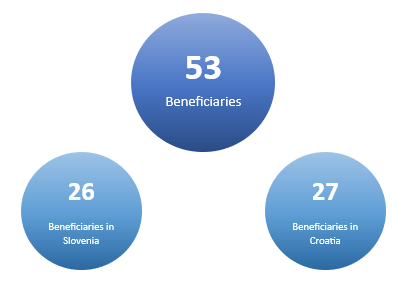
Beneficiaries in Slovenia
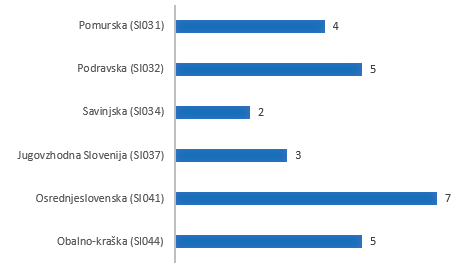
Beneficiaries in Croatia
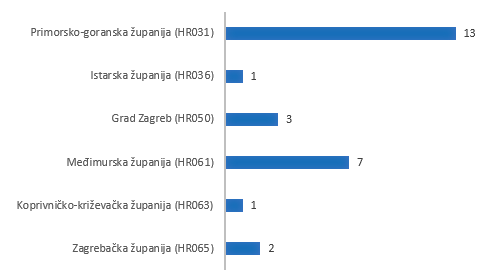
Specific Objectives
Number of projects by specific objectives




